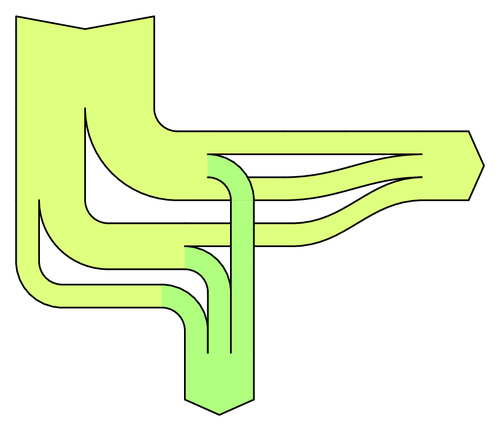This document contains a new environment called sankeydiagram.
Its optional argument is useful to fix some global parameters:
- sankey tot quantity is a number and represents the total quantity of the global flow (default value: 100 for 100%).
- sankey tot length is the width of the global flow (default value: 100pt).
- sankey min radius is the minimum radius of each turn (default value: 30pt).
- sankey fill is the style used to fill the flows.
- sankey draw is the style used to draw the flows.
- sankey debug (a flag) is useful to debug a diagram during its construction (default value: false).
The sankeydiagram environment defines some useful commands to construct a sankey diagram:
- sankeynode{prop}{angle}{name}{pos} makes a sankey node (a flow) of prop capacity (in quantity units), named name. Its orientation and position are given by angle and pos.
- sankeynodestart and sankeynodeend are similar to sankeynode (same arguments) but make respectively and flow starting and a flow ending.
- sankeyadvance{name}{distance} moves forward the sankey node named name.
- sankeyturn{name}{angle} turns the sankey node named name.
- sankeyfork{name}{list of forks} forks the sankey node named name. The list of forks is a list of pairs: quantity/name (the sum of quantities must be equal to the quantity of sankey node to fork).
Uncomment the option sankey debug to get labels for drafting and debugging, as you can see in the second picture.
This code was written by Paul Gaborit and published on TeX.SE.

Edit and compile if you like:
\documentclass{article}
\usepackage{tikz}
\usepackage[active,tightpage]{preview}
\PreviewEnvironment{tikzpicture}
\setlength\PreviewBorder{10pt}%
\usetikzlibrary{calc}
\usepackage{etoolbox}
\pgfdeclarelayer{background}
\pgfdeclarelayer{foreground}
\pgfdeclarelayer{sankeydebug}
\pgfsetlayers{background,main,foreground,sankeydebug}
\newif\ifsankeydebug
\newenvironment{sankeydiagram}[1][]{
\def\sankeyflow##1##2{% sn, en
\path[sankey fill]
let
\p1=(##1.north east),\p2=(##1.south east),
\n1={atan2(\x1-\x2,\y1-\y2)-90},
\p3=(##2.north west),\p4=(##2.south west),
\n2={atan2(\x3-\x4,\y3-\y4)+90}
in
(\p1) to[out=\n1,in=\n2] (\p3) --
(\p4) to[in=\n1,out=\n2] (\p2) -- cycle;
\draw[sankey draw]
let
\p1=(##1.north east),\p2=(##1.south east),
\n1={atan2(\x1-\x2,\y1-\y2)-90},
\p3=(##2.north west),\p4=(##2.south west),
\n2={atan2(\x3-\x4,\y3-\y4)+90}
in
(\p1) to[out=\n1,in=\n2] (\p3)
(\p4) to[in=\n1,out=\n2] (\p2);
}
\tikzset{
sankey tot length/.store in=\sankeytotallen,
sankey tot quantity/.store in=\sankeytotalqty,
sankey min radius/.store in=\sankeyminradius,
sankey arrow length/.store in=\sankeyarrowlen,
sankey debug/.is if=sankeydebug,
sankey debug=false,
sankey flow/.style={
to path={
\pgfextra{
\pgfinterruptpath
\edef\sankeystart{\tikztostart}
\edef\sankeytarget{\tikztotarget}
\sankeyflow{\sankeystart}{\sankeytarget}
\endpgfinterruptpath
}
},
},
sankey node/.style={
inner sep=0,minimum height={sankeyqtytolen(##1)},
minimum width=0,draw=none,line width=0pt,
},
% sankey angle
sankey angle/.store in=\sankeyangle,
% sankey default styles
sankey fill/.style={line width=0pt,fill,white},
sankey draw/.style={draw=black,line width=.4pt},
}
\newcommand\sankeynode[4]{%prop,orientation,name,pos
\node[sankey node=##1,rotate=##2] (##3) at (##4) {};
\ifsankeydebug
\begin{pgfonlayer}{sankeydebug}
\draw[red,|-|] (##3.north west) -- (##3.south west);
\pgfmathsetmacro{\len}{sankeyqtytolen(##1)/3}
\draw[red] (##3.west)
-- ($(##3.west)!\len pt!90:(##3.south west)$)
node[font=\tiny,text=black] {##3};
\end{pgfonlayer}
\fi
}
\newcommand\sankeynodestart[4]{%prop,orientation,name,pos
\sankeynode{##1}{##2}{##3}{##4}
\begin{scope}[shift={(##3)},rotate=##2]
\path[sankey fill]
(##3.north west) -- ++(-\sankeyarrowlen,0)
-- ([xshift=-\sankeyarrowlen/6]##3.west)
-- ([xshift=-\sankeyarrowlen]##3.south west)
-- (##3.south west) -- cycle;
\path[sankey draw]
(##3.north west) -- ++(-\sankeyarrowlen,0)
-- ([xshift=-\sankeyarrowlen/6]##3.west)
-- ([xshift=-\sankeyarrowlen]##3.south west)
-- (##3.south west);
\end{scope}
}
\newcommand\sankeynodeend[4]{%prop,orientation,name,pos
\sankeynode{##1}{##2}{##3}{##4}
\begin{scope}[shift={(##3)},rotate=##2]
\path[sankey fill]
(##3.north east)
-- ([xshift=\sankeyarrowlen]##3.east)
-- (##3.south west) -- cycle;
\path[sankey draw]
(##3.north east)
-- ([xshift=\sankeyarrowlen]##3.east)
-- (##3.south west);
\end{scope}
}
\newcommand\sankeyadvance[3][]{%newname,name,distance
\edef\name{##2}
\ifstrempty{##1}{
\def\newname{##2}
\edef\name{##2-old}
\path [late options={name=##2,alias=\name}];
}{
\def\newname{##1}
}
\path
let
% sankey node angle
\p1=(##2.north east),
\p2=(##2.south east),
\n1={atan2(\x1-\x2,\y1-\y2)-90},
% sankey prop
\p3=($(\p1)-(\p2)$),
\n2={sankeylentoqty(veclen(\x3,\y3))},
% next position
\p4=($(##2.east)!##3!-90:(##2.north east)$)
in
\pgfextra{
\pgfmathsetmacro{\prop}{\n2}
\pgfinterruptpath
\sankeynode{\prop}{\n1}{\newname}{\p4}
\path (\name) to[sankey flow] (\newname);
\endpgfinterruptpath
};
}
\newcommand\sankeyturn[3][]{%newname,name,angle
\edef\name{##2}
\ifstrempty{##1}{
\def\newname{##2}
\edef\name{##2-old}
\path [late options={name=##2,alias=\name}];
}{
\def\newname{##1}
}
\ifnumgreater{##3}{0}{
\typeout{turn acw: ##3}
\path
let
% sankey node angle
\p1=(##2.north east),
\p2=(##2.south east),
\p3=($(\p1)!-\sankeyminradius!(\p2)$),
\n1={atan2(\x1-\x2,\y1-\y2)-90},
% sankey prop
\p4=($(\p1)-(\p2)$),
\n2={sankeylentoqty(veclen(\x4,\y4))},
\p5=(##2.east),
\p6=($(\p3)!1!##3:(\p5)$)
in
\pgfextra{
\pgfmathsetmacro{\prop}{\n2}
\pgfinterruptpath
% \fill[red] (\p3) circle (2pt);
% \fill[blue](\p6) circle (2pt);
\sankeynode{\prop}{\n1+##3}{\newname}{\p6}
\path (\name) to[sankey flow] (\newname);
\endpgfinterruptpath
};
}{
\typeout{turn acw: ##3}
\path
let
% sankey node angle
\p1=(##2.south east),
\p2=(##2.north east),
\p3=($(\p1)!-\sankeyminradius!(\p2)$),
\n1={atan2(\x1-\x2,\y1-\y2)+90},
% sankey prop
\p4=($(\p1)-(\p2)$),
\n2={sankeylentoqty(veclen(\x4,\y4))},
\p5=(##2.east),
\p6=($(\p3)!1!##3:(\p5)$)
in
\pgfextra{
\pgfmathsetmacro{\prop}{\n2}
\pgfinterruptpath
% \fill[red] (\p3) circle (2pt);
% \fill[blue](\p6) circle (2pt);
\sankeynode{\prop}{\n1+##3}{\newname}{\p6}
\path (\name) to[sankey flow] (\newname);
\endpgfinterruptpath
};
}
}
\newcommand\sankeyfork[2]{%name,list of forks
\def\name{##1}
\def\listofforks{##2}
\xdef\sankeytot{0}
\path
let
% sankey node angle
\p1=(\name.north east),
\p2=(\name.south east),
\n1={atan2(\x1-\x2,\y1-\y2)-90},
% sankey prop
\p4=($(\p1)-(\p2)$),
\n2={sankeylentoqty(veclen(\x4,\y4))}
in
\pgfextra{
\pgfmathsetmacro{\iprop}{\n2}
}
\foreach \prop/\name[count=\c] in \listofforks {
let
\p{start \name}=($(\p1)!\sankeytot/\iprop!(\p2)$),
\n{nexttot}={\sankeytot+\prop},
\p{end \name}=($(\p1)!\n{nexttot}/\iprop!(\p2)$),
\p{mid \name}=($(\p{start \name})!.5!(\p{end \name})$)
in
\pgfextra{
\xdef\sankeytot{\n{nexttot}}
\pgfinterruptpath
\sankeynode{\prop}{\n1}{\name}{\p{mid \name}}
\endpgfinterruptpath
}
}
\pgfextra{
\pgfmathsetmacro{\diff}{abs(\iprop-\sankeytot)}
\pgfmathtruncatemacro{\finish}{\diff<0.01?1:0}
\ifnumequal{\finish}{1}{}{
\message{*** Warning: bad sankey fork (maybe)...}
\message{\iprop-\sankeytot}
}
};
}
\tikzset{
% default values,
declare function={
sankeyqtytolen(\qty)=\qty/\sankeytotalqty*\sankeytotallen;
sankeylentoqty(\len)=\len/\sankeytotallen*\sankeytotalqty;
},
sankey tot length=100pt,
sankey tot quantity=100,
sankey min radius=30pt,%
sankey arrow length=10pt,%
% user values
#1}
}{
}
\begin{document}
\begin{tikzpicture}[x=1pt,y=1pt]
\begin{sankeydiagram}[
sankey tot length=90pt,%
sankey tot quantity=6,%
sankey min radius=15pt,%
sankey fill/.style={
draw,line width=0pt,
fill,
lime!50,
},
sankey draw/.style={
draw=black,
line width=1pt,
line cap=round,
line join=round,
},
%sankey debug,
]
\sankeynodestart{6}{-90}{p0}{0,100};
\sankeyadvance{p0}{50pt}
\sankeyfork{p0}{3/p1,3/p2}
\sankeyturn{p1}{90}
\sankeyadvance{p1}{20pt}
\sankeyadvance{p2}{60pt}
\sankeyfork{p2}{2/p3,1/p4}
\sankeyturn{p3}{90}
\sankeyadvance{p3}{50pt}
\sankeyfork{p3}{1/p5,1/p6}
\sankeyadvance{p5}{70pt}
\sankeyfork{p1}{1/p7,1/p8,1/p9}
\sankeyadvance{p7}{50pt}
\sankeyadvance{p9}{50pt}
\sankeyadvance{p4}{40pt}
\sankeyturn{p4}{90}
\sankeyadvance{p4}{65pt}
\sankeyadvance{p7}{40pt}
\sankeynode{3}{0}{p11}{[shift={(50pt,-15pt)}]p7}
\sankeyfork{p11}{1/p7a,1/p9a,1/p5a}
\path (p7) to[sankey flow] (p7a);
\path (p9) to[sankey flow] (p9a);
\path (p5) to[sankey flow] (p5a);
\sankeyadvance{p11}{30pt}
\sankeynodeend{3}{0}{p11}{p11}
{
\tikzset{
sankey fill/.append style={
line width=0pt,
lime!50!green!50,
}
}
\sankeyturn{p8}{-90}
\sankeyadvance{p8}{40pt}
\sankeyturn{p6}{-90}
\sankeyturn{p4}{-90}
\sankeynode{3}{-90}{p10}{[shift={(-15pt,-60pt)}]p8}
\sankeyfork{p10}{1/p8a,1/p6a,1/p4a}
\path (p4) to[sankey flow] (p4a);
\path (p6) to[sankey flow] (p6a);
\path (p8) to[sankey flow] (p8a);
\sankeyadvance{p10}{30pt}
\sankeynodeend{3}{-90}{p10}{p10}
}
\end{sankeydiagram}
\end{tikzpicture}
\end{document}Click to download: sankey-diagram.tex • sankey-diagram.pdf
Open in Overleaf: sankey-diagram.tex